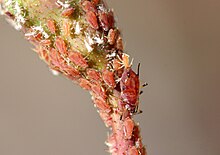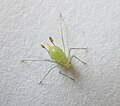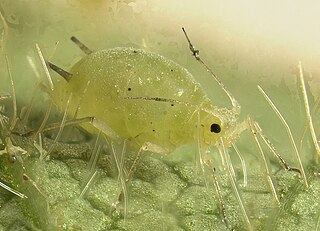
The Aphididae are a very large insect family in the aphid superfamily (Aphidoidea), of the order Hemiptera. These insects suck the sap from plant leaves. Several thousand species are placed in this family, many of which are considered plant/crop pests. They are the family of insects containing most plant virus vectors with the green peach aphid being one of the most prevalent and indiscriminate carriers.

Coccinella transversalis, commonly known as the transverse ladybird or transverse lady beetle, is a species of ladybird beetle found from India across southern and southeastern Asia to Malesia and Australia. It is not to be confused with Coccinella transversoguttata, a widespread species in Europe and North America also known as the transverse ladybird. The alternative vernacular of small transverse ladybird may be used for C. transversalis in instances where these two species are discussed together.

Macrosiphum rosae, the rose aphid, is a species of sap-sucking aphids in the subfamily Aphidinae. They have a world-wide distribution and infest rosebushes as the main host in spring and early summer, congregating on the tips of shoots and around new buds. Later in the summer, winged forms move to other rose bushes, or to a limited number of secondary hosts, before returning to rosebushes to lay eggs in the autumn.

Nasonovia ribisnigri is a species of aphid. Their primary hosts are currant plants, including blackcurrants and gooseberries, while the secondary hosts are a wider range of plants, including members of the Compositae, Lamiales and Solanaceae. They are an important agricultural pest in lettuce and endive cultivation.

Macrosiphum euphorbiae, the potato aphid, is a sap-sucking pest insect in the family Aphididae. It infests potatoes and a number of other commercially important crops.

Aphelinus abdominalis is a parasitoid wasp and biocontrol agent used to control several aphid species that are pests of agricultural crops, including the potato aphid Macrosiphum euphorbiae.

Blueberry shoestring virus (BBSSV) is a disease-causing virus that is commonly transmitted by the aphid vector, Illinoia pepperi. The blueberry shoestring virus disease is very prominent in highbush and lowbush blueberry plants in the northeastern and upper Midwest of the United States. Symptoms can vary significantly depending on the environment, but the most common disease symptoms are reddish streaking on young stems, reduced vigor and strap-shaped leaves. The blueberry shoestring virus disease can be managed by eliminating the aphid vector through the use of biological, chemical or cultural controls. In severe cases, the disease leads to an extensive loss of yield and marketable fruit.
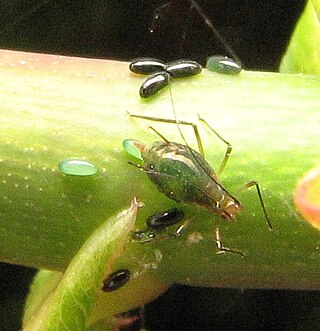
Aphidinae is an aphid subfamily in the family Aphididae.

Dysaphis crataegi, the hawthorn-carrot aphid, is an aphid in the superfamily Aphidoidea in the order Hemiptera. It is a true bug and sucks sap from plants.
Aphidius nigripes is a species of parasitoid wasp in the subfamily Aphidiinae of the family Braconidae. It is the most common parasitoid of the potato aphid Macrosiphum euphorbiae in eastern North America. Many other species of aphids may also serve as hosts.
Hyadaphis coriandri, the coriander aphid, is a species of aphid in the family Aphididae.
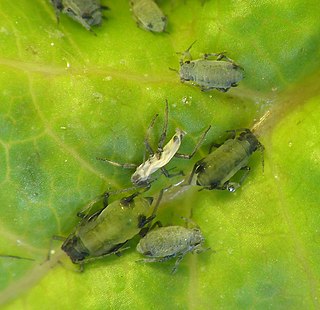
Hyadaphis is a genus of aphids in the family Aphididae. There are about 19 described species in Hyadaphis.

Macrosiphum albifrons, the lupin aphid, is a species of large grey/ green aphid in the family Aphididae.
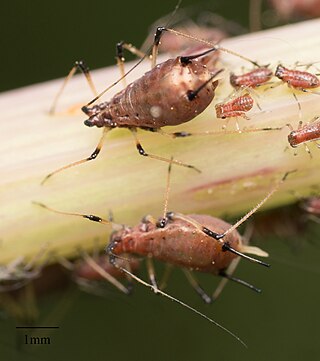
Uroleucon sonchi is a species of aphid in the family Aphididae. Known as the large sow-thistle aphid, it is a native of Europe, and has been introduced to several other countries. It principally feeds on the sow thistle but is also a pest of cultivated lettuce, and so is also known as the brown lettuce aphid.

Anegleis cardoni, is a species of lady beetle found in India, Pakistan and Sri Lanka.

Scymnus (Pullus) latemaculatus, is a species of lady beetle found in Pakistan, India, Bangladesh, Sri Lanka, Thailand, and Taiwan.

Scymnus (Scymnus) nubilus, is a species of lady beetle found in Pakistan, India, Bangladesh, Sri Lanka, Nepal, Myanmar, China, and Asia Minor.

Scymnus (Pullus) coccivora, is a species of lady beetle found in India, Bangladesh, Sri Lanka, Malaysia, and Pakistan and probably in Thailand, Bermuda, British Virgin Islands, Grenada, Saint Kitts and Nevis, Trinidad and Tobago and Papua New Guinea.
